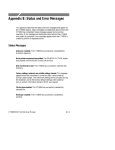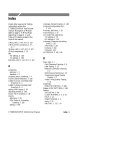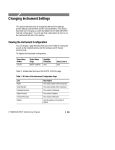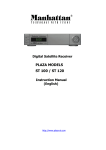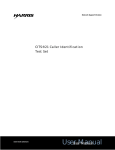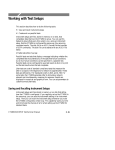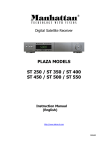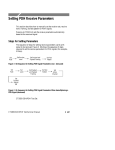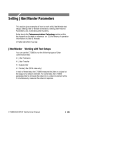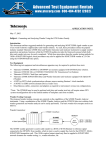Download Getting Started
Transcript
Getting Started This section provides a description of the CTS850, a list of standard and optional accessories, and explains how to operate the CTS850 for the first time. Product Description The Tektronix CTS850 SDH/PDH Test Set is a rugged, portable test set designed for installing and maintaining telecommunications networks. The CTS850 is an SDH analyzer that combines bit error rate test capabilities with overhead testing, payload mapping, and demapping in one unit. The CTS850 features the following capabilities: H STM-0E, STM-0, STM-1E, STM-1, STM-4, 2 Mb/s, 8 Mb/s, 34 Mb/s, and 140 Mb/s transmit and receive H Optical interface available at 1310 nm and 1550 nm H Bit Error Rate testing H BER test of VC4 4c concatenated payloads at 622 Mbit/s H 45 Mbit/s mapping and demapping into SDH (optional) H BIP error monitoring and analysis H 2, 8, 34 and 140 Mbit/s PDH multiplexing/demultiplexing (MUX/DEMUX) with N/Mx64 kbit/s testing H Payload mapping and demapping H Jitter generation and analysis H Wander generation and measurement (Real Time Wander Analyst PC application software for TDEV/MTIE) H Unique timing quality measurement H Pointer generation, including sequences and analysis H Alarm generation and analysis CTS850 SDH/PDH Test Set User Manual 1 1 Getting Started H TU error monitoring and analysis H Performance monitoring per G.821, G.826, M.2100 and M.2101.1 on all layers simultaneously H Automatic Protection Switching (APS) testing H DCC and user channel access H Programmable via IEEE 488.2 and RS-232 The CTS850 meets the needs of the craftsperson and the network engineer. The CTS850 meets the requirements of those working in network installation and maintenance by providing the capability to perform: H Network integrity testing H In-service performance monitoring H Stimulus and response testing H Stress testing H Overhead testing H Automated jitter conformance testing H G.821, G.826, M.2100 and M.2101.1 performance measurement Accessories Some accessories are included with the CTS850 SDH/PDH Test Set. If you wish to purchase optional accessories or additional standard accessories, see a Tektronix products catalog or contact your local Tektronix field representative. Standard Accessories H CTS850 SDH/PDH Test Set User Manual, Tektronix part number 070-9988-XX H CTS850 SDH/PDH Test Set Reference Manual on CD ROM, Tektronix part number 063 3013 XX 1 2 CTS850 SDH/PDH Test Set User Manual Getting Started H CTS 850 SDH/PDH Test Set Programmer Manual, Tektronix part number 070-9990-XX H Instrument Front Cover, Tektronix part number 200-3232-XX H 75 loopback BNC cable, Tektronix part number 012-1338-XX H Pouch (to hold printer, user manual, etc.) Tektronix part number 016-1266-XX Optional Accessories H CTS 850 SDH Test Set Service Manual (Tektronix part number 070-9991-XX) H Electrical STS 0E/1E and STM 1 Plug in (Standard) H FC, SC or ST Optical Connectors H 1.6/1.5 connectors for all 75 Ohm BNC front panel connectors H 2,8,34, 140 Mbit/s, VC 12, TU 3 Add/Drop Test H Universal European: 220 V, 50 Hz power cord H UK: 240 V, 50 Hz power cord H Australian: 240 V, 50 Hz power cord H North American: 240 V, 60 Hz power cord H Switzerland: 220 V, 50 Hz H Hard Transit Case, Tektronix part number 016-1157-XX H Soft Carrying Bag, Tektronix part number 016-1158-XX H Optical Connector Kit, Tektronix part number 020-1885-XX CTS850 SDH/PDH Test Set User Manual 1 3 Getting Started Navigation CTS 850 Paper basedManual & CD ROM The following table shows you where to quickly find the section that answers your particular test & measurement questions. In order to get you going as fast as possible with the CTS 850 test set, the paper based user manual focuses solely on Getting Started information. Everything else appears in the reference manual on CD ROM, including all information contained in the paper based user manual. Table 1 1:Where to Find Information in this User Manual Look in this part of the manual: If you want to know how to: Use the basic functions of the test set, including Controls, indicators, connectors; Elements of front panel display; Menu structure; Online help; Connecting signals; Selection and editing of choices; Disk drive operation Functional Overview, Chapter 2 Tutorial Tutorial, Chapter 2 Setup and use the test set for network and equipment test applications, including * Network continuity checking * Transmission signal quality testing * Fault tolerance testing * Performance monitoring * Jitter and wander testing * Video timing quality testing Basic Test Procedures, Chapter 3 (paper basedand reference manual on CD) (paper basedand reference manual on CD) Set TX (SDH, PDH) (reference manual on CDonly) Set transmit rate; specify the AU under test; set the payload mapping and content; and set the overhead bytes for SDH signals Setting SDH Transmit Parameters, Chapter 3 Set transmit rate, transmit clock, line clock offset, Setting PDH Transmit payload, framing, test pattern, active channel and Parameters, Chapter 3 background pattern for PDH signals 1 4 CTS850 SDH/PDH Test Set User Manual Getting Started Table 1 1:Where to Find Information in this User Manual (Cont.) If you want to know how to: Set RX (SDH, PDH) (reference manual on CDonly) Look in this part of the manual: Set receive line rate; specify the AU under test; set payload mapping and content; check received optical signal power; view overhead bytes for SDH Setting SDH Receive Parameters, Chapter 3 Set the receive rate, receive level, framing and test pattern for PDH signals Setting PDH Receive Parameters, Chapter 3 Jitter/Wander Set TX/RX, Work with Test Setups, Calibrate (paper basedand reference manual on CD) Setting Jitter/Wander Parameters, Chapter 3 Set & Test Alarms, Errors, Pointers, Timing, APS (reference manual on CDonly) Generate error conditions, set alarms, and simulate network failures Setting Alarms and Inserting Errors, Chapter 3 Generate Automatic Protection Switching (APS) commands and view the network response Testing Automatic Protection Switching, Chapter 3 Set the duration for a test, the resolution of test history, start and stop a test Setting Test Control Parameters, Chapter 3 Save and recall instrument setups; Create and run pass/fail tests Working with Test Setups, Chapter 3 Change date and time settings, printer settings, GPIB, RS 232parameters. Run a self test Changing Instrument Settings, Chapter 3 View, Print, Save & Recall Measurements (reference manual on CDonly) Monitor input signal for alarms, errors and Checking Signal Status, failures, indicating current signal status, history of Chapter 3 signal status View, save, recall, and print test results CTS850 SDH/PDH Test Set User Manual Viewing Results, Chapter 3 1 5 Getting Started Table 1 1:Where to Find Information in this User Manual (Cont.) Look in this part of the manual: If you want to know how to: Appendices (reference manual on CDonly) Review available menu choices; Navigate menus Menu Maps, Appendix A 1 6 Interpret Status & Error Messages Status & Error Messages, Appendix B Review Default Factory Settings Default Factory Settings, Appendix C Check all Specifications Specifications, Appendix D Verify the test set functions properly Incoming Inspection Test, Appendix E Check examples of instrument setups, test results and pass/fail tests that can be loaded into the test set Example Disk Contents, Appendix F Explain Rear PanelConnectors Rear PanelConnectors, Appendix G Change Optical Port Connectors Changing Optical Port Connectors, Appendix H Pack for Shipment Packing for Shipment, Appendix I Review telecommunications technology used by the test set Telecommunications Technology, Appendix J Look up word meanings in Glossary; review ITU Tstandards used by the test set Glossary and ITU T Standards CTS850 SDH/PDH Test Set User Manual Getting Started First Time Operation This section describes how to set up the CTS850 for the first time. Installing the Accessory Pouch The CTS850 ships with an accessory pouch that mounts on top of the instrument. The pouch is not installed at the factory. To install the accessory pouch: 1. Place the CTS850 on a table or work bench with the front facing toward you. 2. Center the pouch plate and insert the rear edge of the plate in the space between the cabinet top and the rear panel trim (see part A of Figure 1 1). 3. Move the pouch sideways as necessary to line up the key slots in the pouch plate with the keys on the rear panel (the plate is centered when it is aligned) and push the plate all the way in (see part B of Figure 1 1). 4. While keeping the pouch plate pushed under the rear panel trim, reach under the pouch plate and carefully remove the backing from the Velcro strip to expose the adhesive on the Velcro strip. The Velcro should remain attached to the pouch plate. 5. Grasp the pouch plate assembly with both hands near the front of the assembly. CTS850 SDH/PDH Test Set User Manual 1 7 Getting Started Rear Panel Trim Gap Pouch Plate Pouch Plate Velcro Strip Rear Panel Trim (Top View) A. Push the pouch plate into the rear panel trim gap. Key Slots Under Rear Panel Trim B. Center the pouch plate to align with key slot under the rear panel trim. Figure 1 1:Installing the Accessory Pouch 1 8 CTS850 SDH/PDH Test Set User Manual Getting Started CAUTION. In the next step, use only enough force to clear the front panel trim with the plate front edge. Excessive force will cause a permanent bow in the plate. 6. Push back on the pouch plate and press down with the heels of your hands to bow the plate enough to slide the front of the plate into the space between the cabinet top and the front panel trim (see Figure 1 2). 7. Move the front of the pouch as needed to line up the slots in the plate with the keys on the front panel. 8. Release the pressure on the plate to allow it to return to its normal flat shape. 9. Press down firmly to secure the Velcro strip to the top of the cabinet top. Velcro Strip Figure 1 2:Inserting the Pouch Under the Front Panel Trim CAUTION. Do not use the D-ring (see Figure 1 3) on the pouch plate to lift the CTS850. Using the D-ring to lift the CTS850 can pull the accessory pouch off the CTS850, resulting in damage to the CTS850.The purpose of the D ring is to provide extra support when the test set is placed in an upright position. CTS850 SDH/PDH Test Set User Manual 1 9 Getting Started DO NOT LIFT Instrument With D-Ring Figure 1 3:Location of the D-Ring on the Accessory Pouch 1 10 CTS850 SDH/PDH Test Set User Manual Getting Started Setting Up the CTS850 Before you use the CTS850, ensure that it is properly set up and powered on. To properly set up the CTS850, do the following: 1. Be sure that the environment in which you will operate the CTS850 is within instrument specifications. Specifications for temperature, relative humidity, altitude, vibrations, and emissions are included in the Appendix. 2. Leave space around the CTS850 for cooling. Verify that the air intake and exhaust holes on the sides of the cabinet (where the fan operates) are free of any airflow obstructions. Leave at least 5 cm (2 in) free on each side. WARNING. To avoid electrical shock, be sure that the power cord is disconnected before checking the fuse. 3. Check the fuse to be sure it is the proper type and rating (see Figure 1 4). The CTS850 works with one of two fuses, depending on the AC supply. Each fuse requires its own cap (see Table 1 2). The CTS850 is shipped with the UL-approved fuse installed. CTS850 SDH/PDH Test Set User Manual 1 11 Getting Started AC Power Connector Ground AC Fuse Figure 1 4:Rear-Panel Controls and Connectors Used in Setup See page 2 4 in the next chapter for a labeling of what each rear panel connector is. See the appendix on Rear Panel Connections for a more comprehensive explanation of the rear panel connectors. Table 1 2:Fuse and Fuse Cap Part Numbers Fuse Tektronix Part Number Fuse Cap Tektronix Part Number 0.25 in × 1.25 in (UL 198.6, 3AG): 8 A FAST, 250 V 159-0046-XX 200-2264-XX 5 mm × 20 mm * (IEC 127): 6.3 A, 250 V 159-0381-XX 200-2265-XX Fuse * If it is necessary to use the extra 5 mm x 20 mm fuse included in the fuseholder, the fuse cap must be removed. 1 12 CTS850 SDH/PDH Test Set User Manual Getting Started 4. Check that you have the proper electrical connections. The CTS850 power requirements are listed in Table 1 3. Table 1 3:Power Requirements Voltage Range Frequency Range 90 132V 50/60 Hz 180 250V 50/60 Hz 100 132V 400 Hz 5. Connect the proper power cord from the rear-panel power connector (see Figure 1 4) to the power system. Turning On the CTS850 To properly turn on the CTS850: 1. Press the front panel ON/STBY button (see figure 1 5). The ON/STBY button controls power to all instrument circuits. The CTS 850 performs an internal self test each time it is turned on. When turned on, it displays a screen that states whether or not it passed the self test. (If the self test passes, the status display screen is removed after a few seconds.) 2. Check the self test results. If the self test fails, contact your local Tektronix Service Center for assistance. CTS850 SDH/PDH Test Set User Manual 1 13 Getting Started CTS850 SDH Test Set ON/STBY Button Figure 1 5:ON/STBY Button Turning Off the CTS850 Press the ON/STBY button to turn off the CTS850. 1 14 CTS850 SDH/PDH Test Set User Manual














